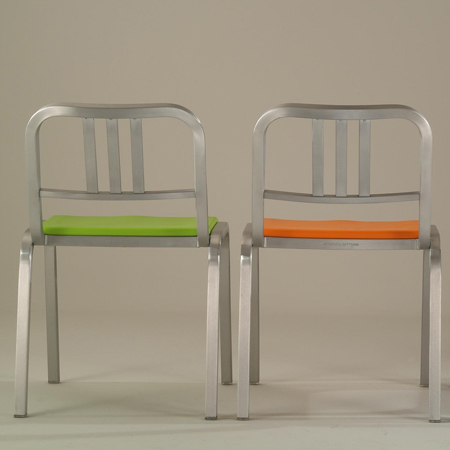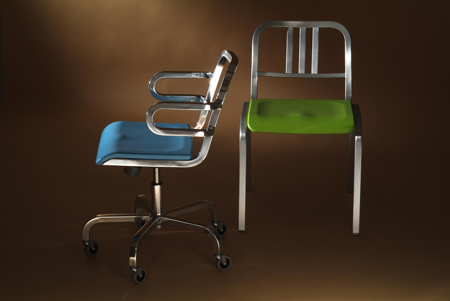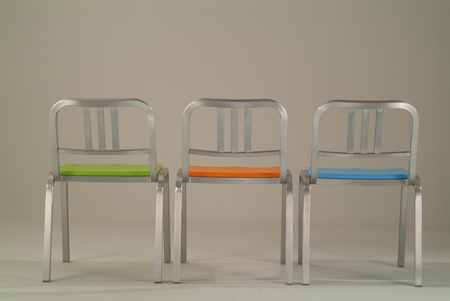
Nine-0 by Ettore Sottsass for Emeco
Milan 08: American manufacturers Emeco will launch Nine-0, the last range of chairs and stools by late Italian designer Ettore Sottsass, at the Milan furniture fair next month.

The range includes stacking chairs and barstools, armchairs, a counter and swivel chairs which reference the Emeco 1006 Navy chair built for submarines and manufactured by Emeco since 1944.

Sottsass died in December 2007 at the age of 90.
Here's some information from Emeco:
--
NINE-0 BY ETTORE SOTTSASS CELEBRATES AN AUTHENTIC CHAIR AND AN ORIGINAL LIFE
Emeco, the Aluminium Chair Company, will debut “Nine-0”, a new collection of chairs and stools by the Italian designer Ettore Sottsass at the 2008 Salone Internazionale del Mobile this April. The new designs re-imagine the classic, all aluminium Emeco 1006 Navy® chair, built for submarines in WWII, and manufactured by Emeco since 1944. These are the last chairs designed by Mr. Sottsass, who died on December 31, 2007 at the age of 90.
"A chair must be really important as an object, because my mother always told me to offer my chair to a lady,” Mr. Sottsass told the Cooper-Hewitt National Design Museum in 1976. “From what I know, practically everyone who considers himself a designer or architect has sooner or later designed some chairs.”
Mr. Sottsass’ collaboration with Emeco began in Chicago eight years ago when Gregg Buchbinder, Emeco’s Chariman, met him at the Chicago Museum of Contemporary Art. "The minute we met, Ettore told me he was an admirer of the Navy chair and in fact wished he had designed it. And we agreed, why not re-design it,” remembers Mr. Buchbinder. “I had seen Sottsass’ projects in Domus magazine over the years – Esprit, the Amazon Express yacht - in which he had used our chair. Ettore was the first designer who took our chairs out of their typical environments -navy ships prisons, hospitals- and to use them in contemporary interior design projects. Through him Sir Terence Conran, Frank Gehry and Philippe Starck discovered the Emeco chair creating resurgence in the 1990’s. It was only right to commission him to celebrate Emeco’s resurrection with a new collection.”
Chris Redfern, the British architect who worked along side Mr. Sottsass for the past 12 years as his design associate at Sottsass Associati recalls, “Ettore always had orange cushions fixed onto his navy chairs at home in Milan and our idea started there. We wanted to make the new chair soft, friendly and of course colorful."
The new collection includes stacking chairs and armchairs, counter and barstools that stack as well, and swivel chairs for meeting or dining. Mixing Emeco’s expertise in aluminium construction with European technologies in polyurethane sculpting, the new designs feature a soft polyurethane seat and a wider “wheel base” for a growing population – creating a new chair that recalls the Navy 1006® but adds comfort and color.
Prices range from US$ 385 for the standard stacking chair, to $1595 for a hand polished swivel armchair. As always, Emeco uses 80% recycled aluminium for the super-strong frames. This collection can be used indoors or out.
Mr. Redfern, Mr. Buchbinder and Emeco updated the classic to Sottsass’ specifications. "To watch Ettore work on the prototype was an incredible experience, the accuracy and acuity of his observations, the knowledge that he had, not only in terms of design but also fully understanding the processes of production, cost and everything else. This chair is the most important thing we have done so far. For me is a tribute to Ettore,” says Mr. Buchbinder.
Mr. Redfern notes, "Nine-o has become a very significant project for me as it was the last one that we designed together. Towards the end of 2007, we both agreed that nine-o was one of the best chairs we'd ever designed in the studio."
EMECO
Emeco was founded in 1944 to make all-aluminum chairs for the US Navy. Gregg Buchbinder purchased the company in 1998 and began a friendship and association with the renowned French architect, Philippe Starck, creating a series of products that united Emeco's historic manufacturing capabilities with Mr. Starck's classic designs for a new century. In 2000, Mr. Starck's Hudson chair for Emeco won the GOOD DESIGN Award and was inducted into the permanent design collection of the Museum of Modern Art in New York. In 2004, Emeco collaborated with the American architect Frank Gehry on Superlight, a chair that utilizes aluminum's ability to be both strong and flexible. Mr. Gehry's chair won another GOOD DESIGN award in 2004 and was included in collections at the San Francisco Museum of Modern Art and the Pinakothek der Modern in Munich. In 2007, Emeco’s collaboration with Norman Foster “20-06” debuted at the Salone Internazionale del Mobile and won another GOOD DESIGN award. From a workforce of 15 craftsmen in 1998, Emeco has quadrupled is its size and recently instated a second manufacturing shift for the first time in 25 years. Emeco has made over 1,000,000 Navy chairs since 1944, and now sells its all-aluminum furniture in 50 countries.
ETTORE SOTTSASS
Ettore Sottsass was born in 1917 in Innsbruck. Like his father, Mr. Sottsass studied architecture. Despite the fascist regime, the Italy of the 1930s was fertile ground for innovation in design, pushing modernism along a distinctive path that set it apart from the rest of Europe. He served in the Italian army as a lieutenant in Montenegro and was interned as a prisoner of war when Italy surrendered. After the war, he established a practice in Turin, designing interiors, and domestic objects before moving to Milan as Italy embarked on post war reconstruction and collaborating with his father on social housing project, as well as designing small craftsman made domestic objects.
Mr. Sottsass spent a brief period in America, working for George Nelson, which gave his work a transatlantic dimension unusual in Italy.
Back in Milan, and boosted by his American experiences, Mr. Sottsass made the move to the industrial mainstream when he was recruited as a consultant to Olivetti. But while working for the company through the 1960s and 1970s he maintained his own studio allowing him to explore a more radical version of what constitutes design than even such an enlightened client as Olivetti could support. His interest in pre industrial cultures fed his work for Olivetti. He was inspired by ritual objects from India, and driven by the search for symbolic meaning in design in an attempt to move beyond simple functionalism.
It was this element in Mr. Sottsass’ approach that lead him to work under the umbrella of Studio Alchymia at the end of the 1970s with a group of like minded designers in questioning the comfortable definitions of contemporary design and subsequently to establish the Memphis movement in 1981. Memphis represented the most coherent attempt to apply post modernism to design. It created an alternative to the aesthetic of functionalism by exploring the emotional potential of design. Memphis looked like a radical departure at the time, but reflected Mr. Sottsass’ continuing preoccupation with the symbolic and decorative qualities of objects, visible in his earliest designs for textiles and ceramics.
Mr. Sottsass was closely involved with Memphis for five years. The group had no formal manifesto, but Memphis was the closest that design, as distinct from architecture had come to producing an avant-garde movement since the early 1960s. At the same time that Memphis exploded, Mr. Sottsass’ partnership, Sottsass Associati expanded rapidly to become Italy’s best-known design consultancy, working in architecture, graphics, interiors, products, and furniture all around the world.
In his ninth decade, Mr. Sottsass returned to designing one off gallery pieces, while still producing challenging contemporary industrial design for mass production.
Nine-0 will debut at the 2008 Salone Internazionale del Mobile, Milan, April 16 – 21 2008 Hall 8, Stand D30, and at the ICFF New York, May 17-20 2008, Stand 1804.